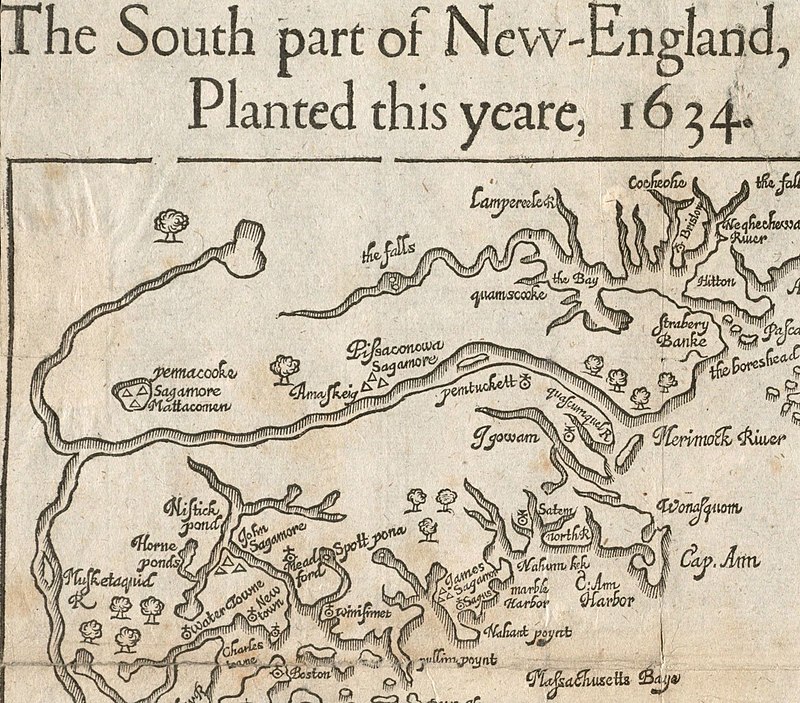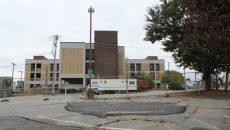(Photo courtesy, William Wood) “William Wood’s 1634 map showing locations of Pawtucket Sagamores James and John”
Steven O’Hara
Connector Staff
A recent project is in its final stages at UMass Lowell, highlighting the history of Indigenous people and bringing to light many of the local unknown tragedies that they have experienced. Signs depicting many instances of Indigenous history will be placed around the UMass Lowell campus and have been tirelessly worked on by students and staff in close collaboration with the Greater Lowell Indian Cultural Association (GLICA).
This project was started during the fall semester of 2021 and is now approaching its final stages of completion. In the fall, students and staff focused on building a concise background of historic events at specific locations around the UMass Lowell campus that would bring awareness to Indigenous history. During the following semester of spring 2022, art students were brought on to create eye-catching graphics and designs that would enhance the inscribed stories and make their messages more palpable. These signs will be erected in the following weeks and will be found at the Tsongas Center, Allen House, Inn & Conference Center and around North and South Campus.
The Indigenous signage project is in recognition of the Pawtucket and Wamesit people who were settled in the Lowell area during the 17th century. Professor Bob Forrant was the lead scholar for this project and was aided by Professor Christopher Strobel in their research.. Strobel, a professor of Native American history and key coordinator for this project, says, “The purpose of the Indigenous signage project is to provide some historic content about some of the often-neglected elements of the past of the greater Lowell area — especially how it relates to Indigenous history.” The signs serve as an acknowledgment of the impact colonizers have made to not only the Indigenous people of Lowell, but of Massachusetts as a whole. Professor Strobel was both a historic researcher for this project and mentor to many of the students who worked on the signs.
Deirdre Hutchinson, a student who was involved in the history portion of this project, worked diligently to acquire the necessary historical context for many of the signs. More specifically, she focused on cultivating details during the uncovering of a set of Indigenous remains during the construction of Southwick Hall and Kitson Hall in the early 20th Century. The burial site was disturbed and bones had been mistreated during the construction process. the sign, which will be found at Kitson quad, will give a more in-depth acknowledgment for what had occurred during construction along with a map of the “Engine Room” that had originally covered this site. Hutchinson believes that the work she and her team did with the project was crucial because it creates continuous awareness for the injustices Indigenous people have had to endure for so long.
Another student who worked on the artistic side of this project, used their knowledge of graphic design to create the striking motifs for the signage. Taylor Szeto, was hired by and worked with their graphic design professor, Ingrid Hess, who used their artistic backgrounds to give life to the signs. Szeto says, “Our main job was to make the 5 signs look presentable. Experience wise, I’ve learned a lot about the process of working in graphic design.” They worked in close collaboration with the team of student historians and professors to translate the messages of the signs both visually and communicatively. These signs are very important, as they don’t shy away from conversation about how Indigenous people were treated and continue to be treated in the United States. They help to keep students and staff alike informed about the tragic history we share and what is also intertwined with our own city and university. In the upcoming weeks, make sure to keep your eyes out for these thoughtfully crafted signs that acknowledge and inform us of the mistreatment of Indigenous people to bring the history of the past into the minds of the present. Professor Strobel gives a final message to the observers about this project’s importance by saying, “The signs seek to remind people of the legacies of colonization and a continuous Indigenous presence.”


